This topic includes:
MADRIX can receive incoming data or can be controlled remotely [DMX Input].
That means you can use another controller or device:
| ▪ | to send data to the software and use this data [e.g., for Scripts, Macros, or tests]. |
| ▪ | to send commands to the software [Remote Control]. |
| ▪ | to route incoming data onto your output [also known as Mapping/Merging/DMX-Thru]. |
In general, 3 options are available to you:
| ▪ | DMX-IN [Receiving DMX input data] |
| ▪ | Art-Net Remote [Receiving Art-Net data] |
| ▪ | sACN Input [Receiving Streaming ACN data] |
Step-By-Step Configuration
1] Enable drivers for your DMX device [e.g., a DMX controller].
2] Activate your DMX device.
3] Enable DMX-IN.
4] Choose how to use incoming signals [as data, for Remote Control, or for Mapping].
1] Enable Drivers For Your DMX Device
| ▪ | Go to Preferences > Options... [Keyboard shortcut: Ctrl+Alt+O] |
| ▪ | A new window will open. |
| ▪ | Choose Devices USB to enable your device. Learn more »Options |
2] Activate Your DMX Device
| ▪ | Go to Preferences > Device Manager... > DMX Devices [Keyboard shortcut: F4] |
| ▪ | A new window will open. |
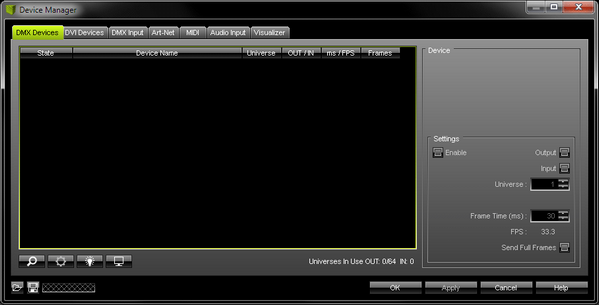
| ▪ | MADRIX may have already found your connected DMX devices. They will be shown in the list. |
| ▪ | Click |
| ▪ | Select your DMX device in the list. |
| ▪ | Activate Enable, and activate Input in the section Settings |
| ▪ | Click Apply to confirm. |

3] Enable DMX-IN
| ▪ | Go to Preferences > Device Manager... > DMX Input |
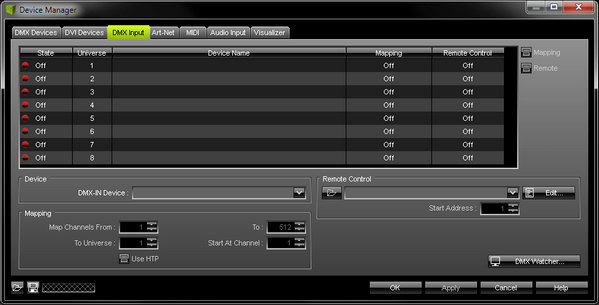
| ▪ | Select your preferred DMX Universe in the list. [By default, DMX universe 1 to 8 are listed. If you wish to increase the number of DMX-IN universes, you can change the setting. Learn more »Performance] |
| ▪ | Choose your DMX-IN Device in the section Device |
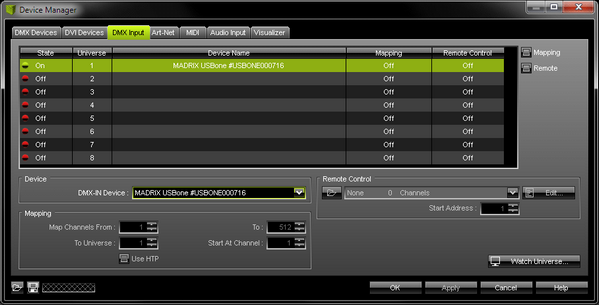
| ▪ | [If needed, you can disable DMX-IN by deselecting the device under DMX-IN Device and choose the list entry that is empty or disable the interface under Device Manager... > DMX Devices] |
4] Choose How To Use Incoming Signals
Data
| ▪ | At this point, MADRIX is now already receiving any incoming data. |
| ▪ | You can now use this data, for example for Scripts and Macros. Learn more »Macros And Scripts |
| ▪ | If you want to monitor incoming signals, select your DMX universe/DMX device in the list and click Watch Universe... Learn more »Tools |
| ▪ | If you want to control MADRIX remotely, first select your device in the list. |
| ▪ | Activate Remote |
| ▪ | Select one of the built-in protocols in the section Remote Control [as explained below] or create your own remote configuration. Learn more »DMX-IN Remote Editor |
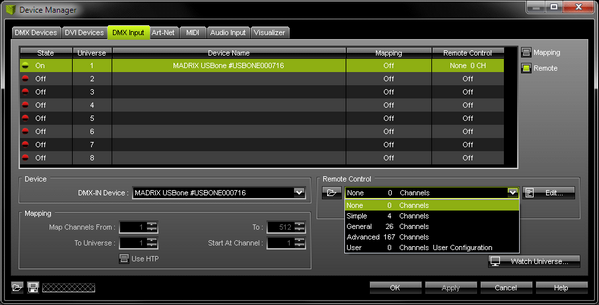
|
Open - Loads a previously saved MADRIX DMX Remote Configuration file [of the file type *.mdrx]. |
|
Protocols - Choose from a pre-configured protocol [configuration]. |
|
DMX-IN Remote Editor - Allows you to modify a configuration or create a new configuration. |
|
Start Address - Defines on which particular DMX channel the protocol should start. The whole protocol will be mapped to this new address area. |
|
DMX Watcher - Opens the DMX Watcher to monitor your DMX output or input |
| ▪ | If you want to route incoming DMX signals through MADRIX to your output [DMX-Thru], first select your device in the list. |
| ▪ | Activate Mapping |
| ▪ | This feature maps incoming data to the specified DMX universe and channels. |
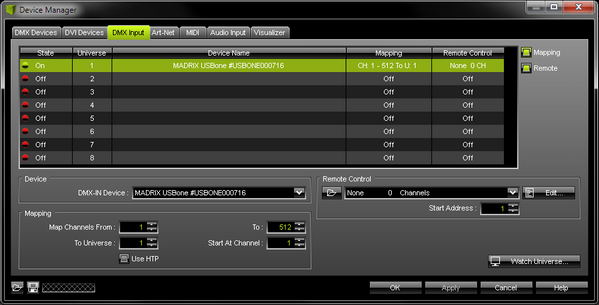
| ▪ | Configure the following settings in the section Mapping - Map Channels From - Defines which incoming channels are used. This is the start channel to specify the range of channels. - To - Defines which incoming channels are used. This is the end channel to specify the range of channels. - To Universe - Defines onto which output DMX universe MADRIX should map the specified range of incoming channels. - Start At Channel - Defines the first DMX channel of the output DMX universe MADRIX should use. - Use HTP - Activates the Highest Takes Precedence feature. You can map incoming data to a DMX address range that MADRIX already controls. Use HTP and MADRIX will compare incoming values with the DMX data it sends to the DMX output. As a result, MADRIX will only use the highest of both values on a particular channel and send it to the output. |
| ▪ | Click Apply to confirm. |
You will need a MADRIX KEY that supports a DMX-based output license in order to be able to use Mapping.
Overview
An Art-Net device can be used for DMX input as well. This feature is called Art-Net Remote.
Step-By-Step Configuration
1] Set up network settings in Windows.
2] Activate Art-Net.
3] Activate the Art-Net Remote device.
4] Enable DMX-IN.
5] Choose how to use incoming signals [as data, Remote Control, Mapping].
1] Set Up Network Settings In Windows
Art-Net is used to send DMX512 data over Ethernet network. Because of this, you need to configure the settings of your network card in Windows first.
| ▪ | Configure your network card in Windows. |
| ▪ | Use an IP address from the following address range: 2.0.0.1 ... 2.255.255.254 or 10.0.0.1 ... 10.255.255.254 |
| ▪ | Use the following Subnet mask 255.0.0.0 |
| ▪ | Learn more »Tips [Microsoft Windows / Networks / USB] |
You must use this address area! Art-Net may not work otherwise.
2] Activate Art-Net
| ▪ | Go to Preferences > Device Manager... > Art-Net [Keyboard shortcut: F4 > Art-Net] |
| ▪ | A new window will open. |
| ▪ | Activate the checkbox Enable [in the upper, right corner]. |
| ▪ | MADRIX will automatically create a new device in the list called ArtNet Remote |
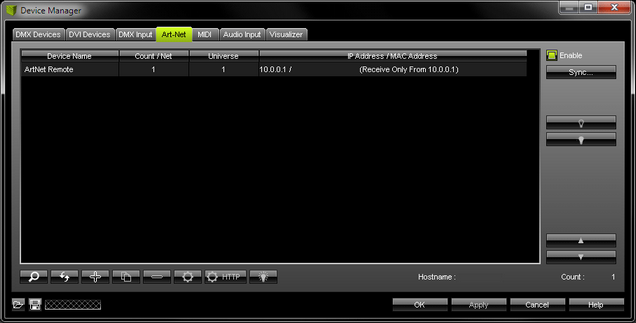
| ▪ | Select ArtNet Remote in the list. |
| ▪ | Click |
| ▪ | A new window will open. |

| ▪ | Configure the following settings: |
| ▪ | Port Count - Defines how many DMX universes can be received by MADRIX. You can choose 1, 2, 3, or 4. [MADRIX can receive a maximum of 4 universes regarding Art-Net Remote.] |
| ▪ | Universe Port OUT - Defines from which DMX universe MADRIX receives the data. - Choose the universe on which your Art-Net device is sending the data! |
| ▪ | Direct IP Mode - If activated, MADRIX will only receive data from the specified IP address. This is the recommended setting. |
| ▪ | IP Address - Needs to be set up if Direct IP Mode is activated. - Enter the IP address of the device that is sending data to MADRIX. - Do not enter the IP address of your MADRIX PC! |
| ▪ | Broadcast Mode - If activated, MADRIX can receive data from all network addresses in the network. - [Any Art-Net device, such as an lighting desk, can send data to MADRIX]. |
| ▪ | Click Apply to confirm. |
| ▪ | Click OK to close the window. |
3] Activate The Art-Net Remote Device
| ▪ | Go to Preferences > Device Manager... > DMX Devices |
| ▪ | Your ArtNet Remote device will be shown in the list. [If the Port Count above is set to 2, 3, or 4, you will see up to 4 devices in the list.] |
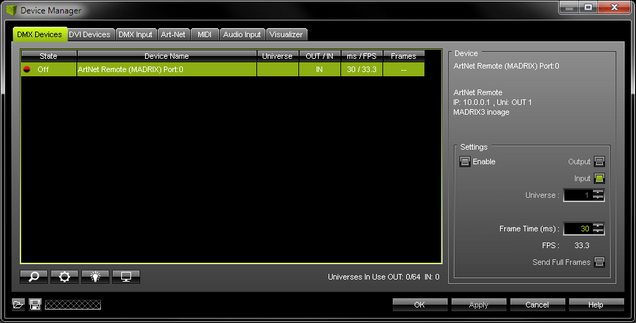
| ▪ | Select your devices in the list. |
| ▪ | Activate Enable in the section Settings. [Input is automatically selected.] |
| ▪ | If needed, adjust Frame Time (ms) to increase or decrease the FPS [Frames Per Second]. |
| ▪ | Click Apply to confirm. |

4] Enable DMX-IN
| ▪ | Go to Preferences > Device Manager... > DMX Input |
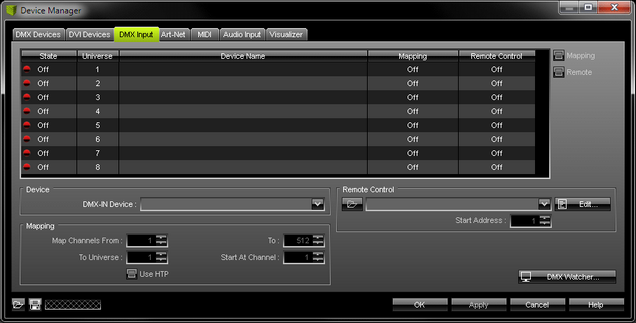
| ▪ | Select your preferred DMX Universe in the list. [By default, DMX universe 1 to 8 are listed. If you wish to increase the number of DMX-IN universes, you can change the setting. Learn more »Performance] |
| ▪ | Select your DMX-IN Device in the section Device by choosing the ArtNet Remote device. |
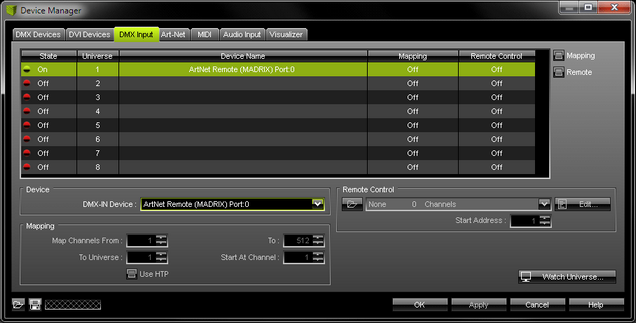
| ▪ | [If needed, you can disable DMX-IN by deselecting the device under DMX-IN Device and choose the list entry that is empty or disable the interface under Device Manager... > DMX Devices.] |
5] Choose How To Use Incoming Signals
Data
| ▪ | At this point, MADRIX is now already receiving any incoming data. |
| ▪ | You can now use this data, for example for Scripts and Macros. Learn more »Macros And Scripts |
| ▪ | If you want to monitor incoming signals, select your DMX universe/DMX device in the list and click Watch Universe... Learn more »Tools |
Remote Control
| ▪ | If you want to control MADRIX remotely, first select your device in the list. |
| ▪ | Activate Remote |
| ▪ | Select one of the built-in protocols in the section Remote Control [as explained below] or create your own remote configuration. Learn more »How To Assign DMX-IN Freely |

|
Open - Loads a previously saved MADRIX DMX Remote Configuration file [of the file type *.mdrx]. |
|
Protocols - Choose from a pre-configured protocol [configuration]. |
|
DMX-IN Remote Editor - Allows you to modify a configuration or create a new configuration. |
|
Start Address - Defines on which particular DMX channel the protocol should start. The whole protocol will be mapped to this new address area. |
|
DMX Watcher - Opens the DMX Watcher to monitor your DMX output or input |
Mapping
| ▪ | If you want to route incoming DMX signals through MADRIX to your output [DMX-Thru], first select your device in the list. |
| ▪ | Activate Mapping |
| ▪ | This feature maps incoming data to the specified DMX universe and channels. |
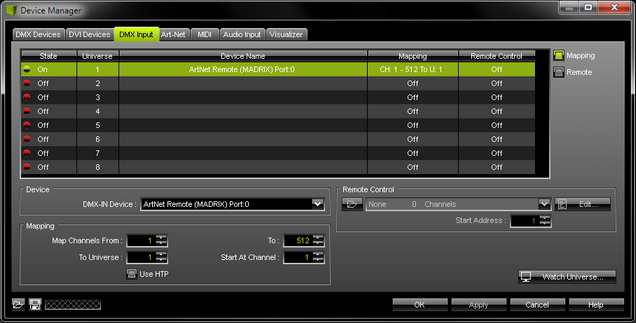
| ▪ | Configure the following settings in the section Mapping - Map Channels From - Defines which incoming channels are used. This is the start channel to specify the range of channels. - To - Defines which incoming channels are used. This is the end channel to specify the range of channels. - To Universe - Defines onto which output DMX universe MADRIX should map the specified range of incoming channels. - Start At Channel - Defines the first DMX channel of the output DMX universe MADRIX should use. - Use HTP - Activates the Highest Takes Precedence feature. You can map incoming data to a DMX address range that MADRIX already controls. Use HTP and MADRIX will compare incoming values with the DMX data it sends to the DMX output. As a result, MADRIX will only use the highest of both values on a particular channel and send it to the output. |
| ▪ | Click Apply to confirm. |
You will need a MADRIX KEY that supports DMX-based output in order to be able to use Mapping.
Art-Net Remote Troubleshooting
If you are encountering problems, please work through the following checklist:
| ▪ | Double-check the settings of your network card. |
| ▪ | Make sure to set up the Windows Firewall correctly. Learn more »Tips [Microsoft Windows / Networks / USB] |
| ▪ | Double-check the settings of the ArtNet Remote device in MADRIX. |
| ▪ | Use the DMX Watcher to monitor incoming data. |
Overview
Streaming ACN devices can be used for DMX input as well.
1] Windows Network Settings
| ▪ | MADRIX automatically sets up Streaming ACN network settings for you. [MADRIX supports multicast Streaming ACN. Data is automatically sent to all corresponding sACN devices in the network.] |
| ▪ | You only need a computer with a network card and a valid IP address. |
| ▪ | You do not have to change the IP address settings in Windows for Streaming ACN! |
| ▪ | The IP address range for sACN devices is 239.255.X.X according to the Streaming ACN specifications. [Even if your sACN devices are set to a different IP address range, you may try the connection from MADRIX to your devices. You can use the MADRIX demo version to test the software prior to purchase.] |
| ▪ | Make sure that your Firewall does not block data of the 239.255.X.X IP address range! |
| ▪ | Check the settings of the Windows Firewall. |
| ▪ | Learn more »Tips [Microsoft Windows / Networks / USB] |
2] Activating Streaming ACN
| ▪ | Go to Preferences > Options... > Devices Network [Keyboard shortcut: Ctrl+Alt+O > Devices Network] |
| ▪ | Activate Enable ACN E1.31 |
| ▪ | Choose your network card from the drop-down list. Make sure to select the correct network adapter that will be used for Streaming ACN! [The IP address and Subnet mask label should help you select the correct adapter. It is not necessary to change any of these networks settings.] |
| ▪ | ACN Device Count - Set up how many you are going to use. [This is the total amount of OUT and IN devices. Please set the exact number of devices you are using. If the count is higher, this creates unnecessary network traffic.] |
| ▪ | Press Apply |
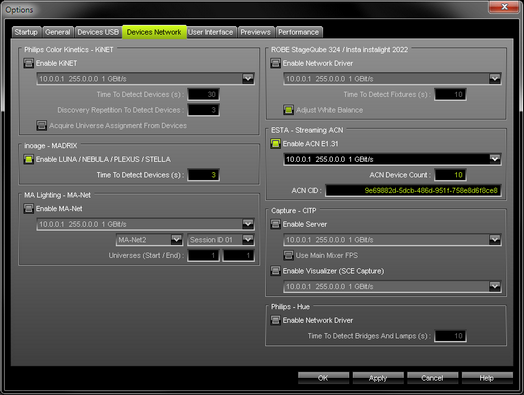
| ▪ | ACN CID - Being a network protocol, Streaming ACN sends a so-called CIDs [Component Identifier]. - Every single ACN device has such a unique ID. - When using Streaming ACN, your MADRIX software is one of those devices. - When you start MADRIX for the first time, this ID will be generated automatically for you. From this point onwards it will be used on your PC. - With this ID your MADRIX software can be easily identified in the network. Interfaces can detect this unique ID and can be configured to receive data from this particular device. Please note that the ACN interface must support this feature. - Do not change the ACN CID, unless you are an experienced user! |
| ▪ | Press OK to close the window. |
3A] Configuration Of Single DMX Devices
| ▪ | Go to Preferences > Device Manager... > DMX Devices [Keyboard shortcut: F4] |
| ▪ | MADRIX automatically creates and adds the number of interfaces to the list. [according to ACN Device Count] |

| ▪ | Select a device in the list and click |
| ▪ | A new window will open. |
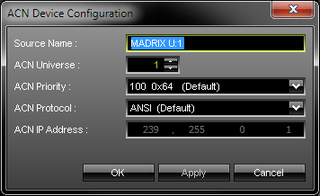
Set up the following settings for your devices:
| ▪ | Source Name - Allows you to set up a specific name for the device. This name is send via network as well. Therefore, interfaces may be able to retrieve this name and can be configured to receive data from this source. - If you are using the default name MADRIX U:X, the universe will automatically be displayed in the name [represented by X: 1, 2, 3, etc.]. |
| ▪ | ACN Universe - Defines the DMX universe of the device. - Set up the same universe that is set up in your sACN device. - According to the Streaming ACN specifications, MADRIX will automatically change the ACN IP Address according to the ACN Universe. |
| ▪ | ACN Priority - Was implemented for backup solutions. Valid values range from 0 to 200, which is the highest priority. - For example, you may have set up two MADRIX PCs. One gets a priority of 100. The second PC gets a priority of 50. If the first PC fails and only if it malfunctions, data will be automatically received from PC #2. - Data will always be received from the device with the highest priority. Please note that the ACN device must support this feature. |
| ▪ | ACN Protocol - Allows you to choose the protocol version. The official version is called ANSI. This option is selected by default. - If you are using an older device that is using the Draft version, you may select BSR. - Do not change the protocol unless you are certain. |
| ▪ | ACN IP Address - Displays the IP address of the device as automatically assigned by MADRIX according to the Streaming ACN specifications. The last 2 digits match the assigned DMX universe. |
| ▪ | Press Apply to confirm your changes. |
| ▪ | Press OK to close the window. |
3B] Configuration Of Multiple DMX Devices
| ▪ | You can configure several interfaces at the same time. |
| ▪ | Follow the steps of 3A, but select multiple devices and press |
| ▪ | A new window will open. |
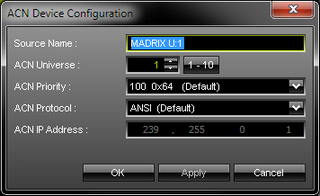
| ▪ | Set up the settings as described under 3A]. |
| ▪ | For ACN Universe you have now additional options for Auto Numbering: |
| ▪ | Press Apply to confirm your changes. |
| ▪ | Press OK to close the window. |
4] Enabling Input
| ▪ | Make sure that your device is still selected under Preferences > Device Manager... > DMX Devices. |
| ▪ | Enable Input if you wish to receive incoming data through this device. |
| ▪ | Click Apply |
| ▪ | In DMX-IN mode, you will not be able to select the ACN protocol. MADRIX will automatically select the correct protocol version. |
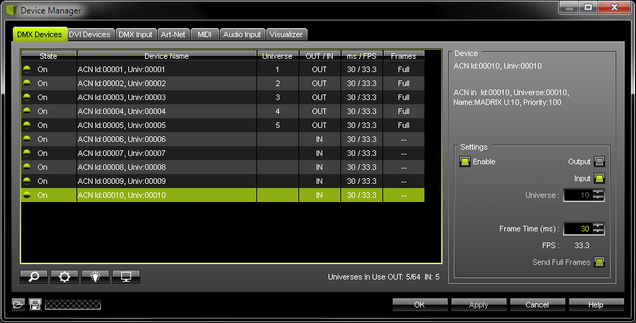
| ▪ | Note: If you are loading a MADRIX Setup, please check if the number of ACN devices in your setup corresponds with the number that is activated. The Setup stores the number of devices. But if you changed the amount and then loaded the Setup, the newly defined number will be activated. |
5] Choose How To Use Incoming Signals
Data
| ▪ | At this point, MADRIX is now already receiving any incoming data. |
| ▪ | You can now use this data, for example for Scripts and Macros. Learn more »Macros And Scripts |
| ▪ | If you want to monitor incoming signals, select your DMX universe/DMX device in the list and click Watch Universe... Learn more »Tools |
Remote Control
| ▪ | If you want to control MADRIX remotely, first select your device in the list. |
| ▪ | Activate Remote |
| ▪ | Select one of the built-in protocols in the section Remote Control [as explained below] or create your own remote configuration. Learn more »How To Assign DMX-IN Freely |

|
Open - Loads a previously saved MADRIX DMX Remote Configuration file [of the file type *.mdrx]. |
|
Protocols - Choose from a pre-configured protocol [configuration]. |
|
DMX-IN Remote Editor - Allows you to modify a configuration or create a new configuration. |
|
Start Address - Defines on which particular DMX channel the protocol should start. The whole protocol will be mapped to this new address area. |
|
DMX Watcher - Opens the DMX Watcher to monitor your DMX output or input |
Mapping
| ▪ | If you want to route incoming DMX signals through MADRIX to your output [DMX-Thru], first select your device in the list. |
| ▪ | Activate Mapping |
| ▪ | This feature maps incoming data to the specified DMX universe and channels. |
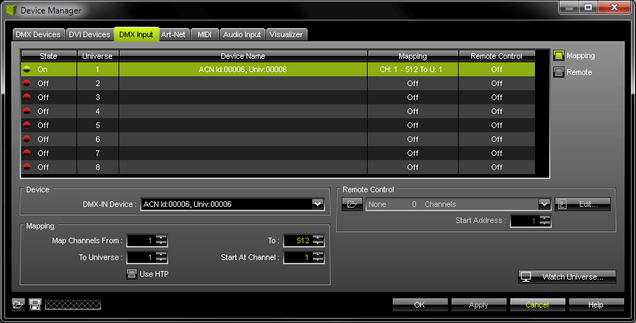
| ▪ | Configure the following settings in the section Mapping - Map Channels From - Defines which incoming channels are used. This is the start channel to specify the range of channels. - To - Defines which incoming channels are used. This is the end channel to specify the range of channels. - To Universe - Defines onto which output DMX universe MADRIX should map the specified range of incoming channels. - Start At Channel - Defines the first DMX channel of the output DMX universe MADRIX should use. - Use HTP - Activates the Highest Takes Precedence feature. You can map incoming data to a DMX address range that MADRIX already controls. Use HTP and MADRIX will compare incoming values with the DMX data it sends to the DMX output. As a result, MADRIX will only use the highest of both values on a particular channel and send it to the output. |
| ▪ | Click Apply to confirm. |
You will need a MADRIX KEY that supports DMX-based output in order to be able to use Mapping.
There are preprogrammed DMX protocols you can choose from:
| ▪ | Please make sure to save your MADRIX Setup file after the configuration process. |
